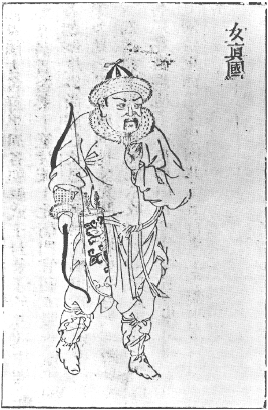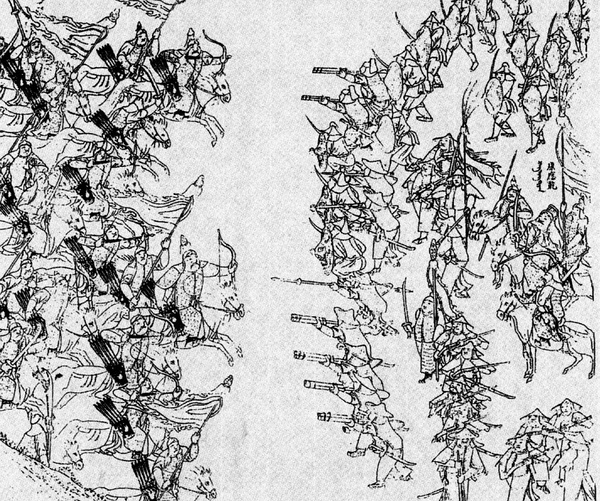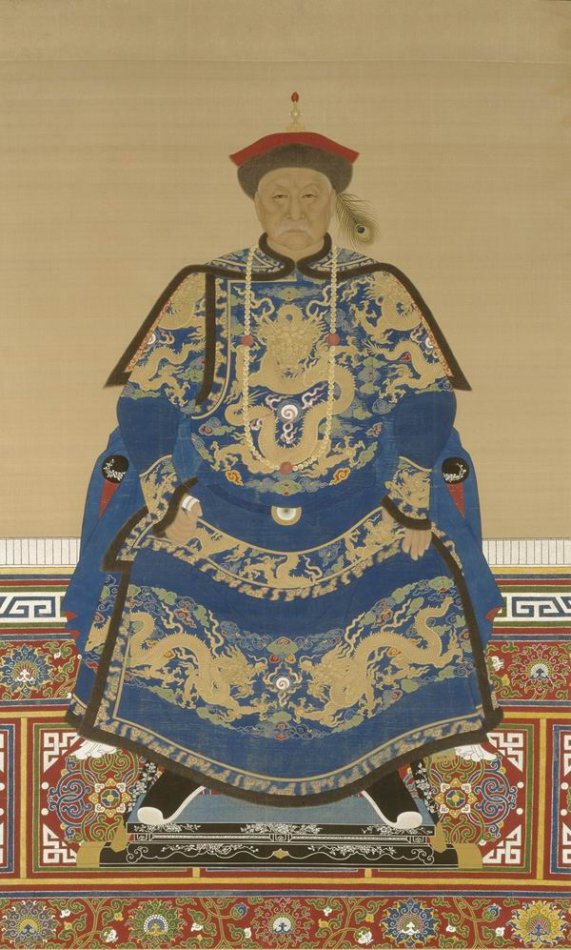|
Shunzhi Emperor, Shunzhi Era
The Shunzhi Emperor (15 March 1638 – 5 February 1661) was the second Emperor of China, emperor of the Qing dynasty of China, and the first Qing emperor to rule over China proper, reigning from 1644 to 1661. A Deliberative Council of Princes and Ministers, committee of Manchu princes chose him to succeed his father, Hong Taiji (1592–1643), in September 1643, when he was five years old. The princes also appointed two co-regents: Dorgon (1612–1650), the 14th son of the Qing dynasty's founder Nurhaci (1559–1626), and Jirgalang (1599–1655), one of Nurhaci's nephews, both of whom were members of the Aisin Gioro, Qing imperial clan. From 1643 to 1650, political power lay mostly in the hands of Dorgon. Under his leadership, the Qing Empire conquered most of the territory of the fallen Ming dynasty (1368–1644), chased Southern Ming, Ming loyalist regimes deep into the southwestern provinces, and established the basis of Qing rule over China proper despite highly unpopular ... [...More Info...] [...Related Items...] OR: [Wikipedia] [Google] [Baidu] |
Emperor Of The Qing Dynasty
The Qing dynasty (1636–1912) was a Manchu-led imperial Chinese dynasty and the last orthodox dynasty of China. It was officially founded in 1636 in what is now Northeast China, but only succeeded the Ming dynasty in China proper in 1644. The Qing dynasty collapsed when the imperial clan (surnamed Aisin Gioro) abdicated in February 1912, a few months after a military uprising had started the Xinhai Revolution that led to the foundation of the Republic of China. Nurhaci (1559–1626), khan of the Jurchens, founded the Later Jin dynasty in 1616 in reference to the Jurchen-led Jin dynasty (1115–1234) that had once ruled over northern China. His son and successor Hong Taiji (1592–1643) renamed his people " Manchu" in 1635 and changed the name of Nurhaci's state from "Great Jin" to "Great Qing" in 1636. Hong Taiji was the real founder of Qing imperial institutions. He was the first to adopt the title of "emperor" (''huangdi'') and founded an Imperial Ancestral Temple in the ... [...More Info...] [...Related Items...] OR: [Wikipedia] [Google] [Baidu] |
Fuquan, Prince Yu
Fuquan ( (8 September 1653 – 10 August 1703), formally known as Prince Yu, was a Manchu prince of the Qing dynasty. He was the second son of the Shunzhi Emperor and a half-brother of the Kangxi Emperor. Life Fuquan was born in the Manchu Aisin Gioro clan as the second son of the Shunzhi Emperor. His mother was Consort Ningque (寧愨妃) from the Donggo (董鄂) clan. Fuquan was conferred the title of "Prince Yu of the First Rank" (裕親王) on February 6, 1671. In August 1690, the Kangxi Emperor granted Fuquan the title of "Generalissimo Who Pacifies Distant Lands" (撫遠大將軍) and sent him to lead a campaign against Galdan Boshugtu Khan, leader of the Dzungar Khanate. Assisted by the Kangxi Emperor's eldest son Yinzhi, Fuquan took his army north through the Gubeikou pass while his brother Changning led his troops through another pass, planning to converge on Galdan's position. Fuquan met and attacked Galdan at Ulan Butung (350 kilometers north of Beijing) on ... [...More Info...] [...Related Items...] OR: [Wikipedia] [Google] [Baidu] |
Aisin Gioro
The House of Aisin-Gioro was a Manchu clan that ruled the Later Jin dynasty (1616–1636), the Qing dynasty (1636–1912), and Manchukuo (1932–1945) in the history of China. Under the Ming dynasty, members of the Aisin Gioro clan served as chiefs of the Jianzhou Jurchens, one of the three major Jurchen tribes at this time. Qing bannermen passed through the gates of the Great Wall in 1644, conquered the short-lived Shun dynasty and the Southern Ming dynasty. The Qing dynasty later expanded into other adjacent regions, including Xinjiang, Tibet, Outer Mongolia, and Taiwan, gaining total control of China. The dynasty reached its zenith during the High Qing era and under the Qianlong Emperor, who reigned from 1735 to 1796. This reign was followed by a century of gradual decline. The house lost power in 1912 following the Xinhai Revolution. Puyi, the last Aisin-Gioro emperor, nominally maintained his imperial title in the Forbidden City until the Articles of Favourable Treatm ... [...More Info...] [...Related Items...] OR: [Wikipedia] [Google] [Baidu] |
Nurhaci
Nurhaci (14 May 1559 – 30 September 1626), also known by his temple name as the Emperor Taizu of Qing (), was a Jurchen chieftain who rose to prominence in the late 16th century in Manchuria. A member of the House of Aisin-Gioro, he reigned as the founding khan of the Later Jin dynasty of China from 1616 to 1626. Nurhaci reorganized and united various Jurchen tribes (the later "Manchu"), consolidated the Eight Banners military system, and eventually launched attacks on both the Ming and Joseon dynasties. His conquest of Ming dynasty's northeastern Liaodong region laid the groundwork for the Qing conquest of the Ming by his descendants, who founded the Qing dynasty in 1636. He is also generally credited with ordering the creation of a new written script for the Manchu language based on the Mongolian vertical script. Name and titles Nurhaci is written as in Manchu language. Some suggest that the meaning of the name in the Manchu language is "the skin of a wild boar", other ... [...More Info...] [...Related Items...] OR: [Wikipedia] [Google] [Baidu] |
Deliberative Council Of Princes And Ministers
The Deliberative Council of Princes and Ministers (), also known as the Council of Princes and High Officials and Assembly of Princes and High Officials, or simply as the Deliberative Council (; ), was an advisory body for the emperors of the early Qing dynasty (1636–1912). Derived from informal deliberative groups created by Nurhaci (1559–1626) in the 1610s and early 1620s, the Council was formally established by his son and successor Hong Taiji (1592–1643) in 1626 and expanded in 1637. Staffed mainly by Manchu dignitaries, this aristocratic institution served as the chief source of advice on military matters for Hong Taiji and the Shunzhi (r. 1643–1661) and Kangxi (r. 1661–1722) emperors. It was particularly powerful during the regencies of Dorgon (1643–1650) and Oboi (1661–1669), who used it to enhance their personal influence. After serving as the most influential policymaking body of the dynasty for more than a century, the Deliberative Council was displaced and ... [...More Info...] [...Related Items...] OR: [Wikipedia] [Google] [Baidu] |
China Proper
China proper, Inner China, or the Eighteen Provinces is a term used by some Western writers in reference to the "core" regions of the Manchu-led Qing dynasty of China. This term is used to express a distinction between the "core" regions populated by the dominant Han population and the "frontier" regions of China, sometimes known as "Outer China". There is no fixed extent for China proper, as many administrative, cultural, and linguistic shifts have occurred in Chinese history. One definition refers to the original area of Chinese civilization, the Central Plain (in the North China Plain); another to the Eighteen Provinces of the Qing dynasty. There is no direct translation for "China proper" in the Chinese language due to differences in terminology used by the Qing to refer to the regions. The expression is controversial among scholars, particularly in China, due to issues pertaining to territorial integrity. Outer China usually includes the geographical regions of Dzungar ... [...More Info...] [...Related Items...] OR: [Wikipedia] [Google] [Baidu] |
Bumbutai
Bumbutai ( mn, Бумбутай; mnc, m= ; zh, 布木布泰; 28 March 1613 – 27 January 1688), of the Khorchin Mongol Borjigit clan, was the consort of Hong Taiji. She was 21 years his junior. She was honoured as Empress Dowager Zhaosheng during the reign of her son, Fulin, the Shunzhi Emperor, and as Grand Empress Dowager Zhaosheng during the reign of her grandson, Xuanye, the Kangxi Emperor. As empress dowager and grand empress dowager, she had significant influence in the Qing imperial court and was highly respected for her political wisdom and insight. After her death, she was posthumously honoured with the title Empress Xiaozhuangwen, although she never held the rank of empress consort during her lifetime. Life Family background * Father: Jaisang (), held the title of a first rank prince () ** Paternal grandfather: Manggusi (), held the title of a first rank prince () ** Paternal aunt: Empress Xiaoduanwen (1599–1649) * Mother: Boli (; d. 1654) * Four elder broth ... [...More Info...] [...Related Items...] OR: [Wikipedia] [Google] [Baidu] |
House Of Aisin-Gioro
The House of Aisin-Gioro was a Manchu clan that ruled the Later Jin dynasty (1616–1636), the Qing dynasty (1636–1912), and Manchukuo (1932–1945) in the history of China. Under the Ming dynasty, members of the Aisin Gioro clan served as chiefs of the Jianzhou Jurchens, one of the three major Jurchen tribes at this time. Qing bannermen passed through the gates of the Great Wall in 1644, conquered the short-lived Shun dynasty and the Southern Ming dynasty. The Qing dynasty later expanded into other adjacent regions, including Xinjiang, Tibet, Outer Mongolia, and Taiwan, gaining total control of China. The dynasty reached its zenith during the High Qing era and under the Qianlong Emperor, who reigned from 1735 to 1796. This reign was followed by a century of gradual decline. The house lost power in 1912 following the Xinhai Revolution. Puyi, the last Aisin-Gioro emperor, nominally maintained his imperial title in the Forbidden City until the Articles of Favourable Treatm ... [...More Info...] [...Related Items...] OR: [Wikipedia] [Google] [Baidu] |
Mongolian Language
Mongolian is the official language of Mongolia and both the most widely spoken and best-known member of the Mongolic language family. The number of speakers across all its dialects may be 5.2 million, including the vast majority of the residents of Mongolia and many of the ethnic Mongol residents of the Inner Mongolia Autonomous Region of the People's Republic of China.Estimate from Svantesson ''et al.'' (2005): 141. In Mongolia, Khalkha Mongolian is predominant, and is currently written in both Cyrillic and traditional Mongolian script. In Inner Mongolia, the language is dialectally more diverse and is written in the traditional Mongolian script. However, Mongols in both countries often use the Latin script for convenience on the Internet. In the discussion of grammar to follow, the variety of Mongolian treated is the standard written Khalkha formalized in the writing conventions and in grammar as taught in schools, but much of what is to be said is also valid for vernacular ... [...More Info...] [...Related Items...] OR: [Wikipedia] [Google] [Baidu] |
Manchu Language
Manchu (Manchu:, ) is a critically endangered East Asian Tungusic language native to the historical region of Manchuria in Northeast China. As the traditional native language of the Manchus, it was one of the official languages of the Qing dynasty (1636–1912) of China, although today the vast majority of Manchus speak only Mandarin Chinese. Several thousand can speak Manchu as a second language through governmental primary education or free classes for adults in classrooms or online. The Manchu language enjoys high historical value for historians of China, especially for the Qing dynasty. Manchu-language texts supply information that is unavailable in Chinese, and when both Manchu and Chinese versions of a given text exist they provide controls for understanding the Chinese. Like most Siberian languages, Manchu is an agglutinative language that demonstrates limited vowel harmony. It has been demonstrated that it is derived mainly from the Jurchen language though there are m ... [...More Info...] [...Related Items...] OR: [Wikipedia] [Google] [Baidu] |
Prince Chun (純)
Prince Chun of the First Rank, or simply Prince Chun, was the title of a princely peerage used in China during the Manchu-led Qing dynasty (1644–1912). As the Prince Chun peerage was not awarded "iron-cap" status, this meant that each successive bearer of the title would normally start off with a title downgraded by one rank ''vis-à-vis'' that held by his predecessor. However, the title would generally not be downgraded to any lower than a ''feng'en fuguo gong'' except under special circumstances. The first bearer of the title was Lunghi (1660–1679), the Shunzhi Emperor's seventh son. In 1674, Lunghi was granted the title "Prince Chun of the First Rank" by his third brother, the Kangxi Emperor. After Lunghi's death, the title was passed on to his infant son, Fu'erhulun (1679–1681), who died prematurely. The peerage thus ended with Fu'erhulun's death. Members of the Prince Chun peerage * Lunghi (隆禧; 1660–1679), the Shunzhi Emperor's seventh son, held the title Pr ... [...More Info...] [...Related Items...] OR: [Wikipedia] [Google] [Baidu] |
Lunghi (prince)
Aisin Gioro Lunghi (隆禧; 30 May 1660 – 20 August 1679) was the Shunzhi Emperor's seventh son. He was the first holder of Prince Chun of the First Rank title from 1674 to 1679. As the peerage was not granted iron-cap status, his successors would hold diminished ranks. Life Lunghi was born to lady Niu (钮氏). As Qing dynasty rulers haven't still developed rank system for imperial consorts, his mother was ranked as a mistress (庶妃). Lunghi's father died shortly after his birth. At that time of Shunzhi Emperor's funeral, his mother was promoted to the position of secondary consort (侧妃). In 1674, Longxi was granted the title Prince Chun of the First Rank. Longxi was appointed as the fourth rank military official in the following year. Longxi died in 1679. His half brother, Kangxi Emperor, cancelled court sessions for 3 days and attended the funeral because Grand Empress Dowager Zhaosheng was unable to attend the ceremony. Lunghi was posthumously honoured as Prince Ch ... [...More Info...] [...Related Items...] OR: [Wikipedia] [Google] [Baidu] |




